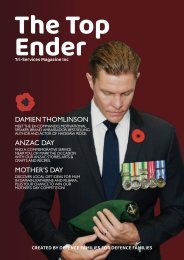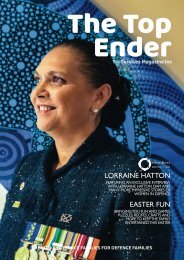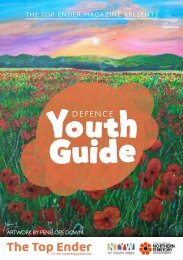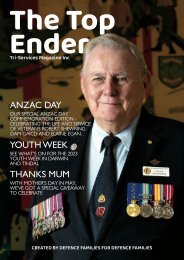The Top Ender Magazine August September 2023 Edition
This edition of The Top Ender Magazine includes competitions, feature interviews, support articles and more. We had the honour to interview Keith Payne, VC AM, the last living recipient of the original Imperial Victoria Cross. We also commemorate significant historical events and acknowledge current events like the Legacy Centenary. Find help and resources that support you to make the most out of your time in the top end of Australia, servicing Darwin, Katherine, Tindal and Pilbara regions.
This edition of The Top Ender Magazine includes competitions, feature interviews, support articles and more. We had the honour to interview Keith Payne, VC AM, the last living recipient of the original Imperial Victoria Cross. We also commemorate significant historical events and acknowledge current events like the Legacy Centenary. Find help and resources that support you to make the most out of your time in the top end of Australia, servicing Darwin, Katherine, Tindal and Pilbara regions.
Create successful ePaper yourself
Turn your PDF publications into a flip-book with our unique Google optimized e-Paper software.
AUSTRALIAN RED CROSS<br />
FOUNDED IN AUG 1914<br />
<strong>The</strong> International Committee of the Red<br />
Cross was formed in 1862. Initially its<br />
purpose was to try and find ways of<br />
overcoming the inadequacy of army medical<br />
services so as to alleviate the suffering of<br />
those wounded in armed conflict. Over<br />
time it has extended its work to include<br />
many forms of humanitarian aid in times of<br />
peace and war.<br />
<strong>The</strong> Australian Red Cross Society (ARCS) was<br />
formed just after the outbreak of the First World<br />
War in <strong>August</strong> 1914, originally as a branch of the the<br />
British Red Cross. Enormous sums of money were<br />
raised, and thousands of women volunteers<br />
contributed their time by making vast quantities of<br />
clothing: socks, vests, mittens, mufflers, pyjamas and a<br />
variety of linen. Items were sent to headquarters<br />
located in the state capitals, often using government<br />
houses as depots, where, after being sorted and<br />
packed by yet more volunteers, they were sent to<br />
Britain or the front. <strong>The</strong> effect of this work for the<br />
recipients was to bring comfort in its truest sense, for<br />
a seemingly trivial gift of a bar of chocolate of a pair of<br />
dry socks could bring the most profound relief for a<br />
soldier on the Western Front. From the date of its<br />
inception until the armistice, the ARCS dispatched<br />
395,695 food parcels and 36,339 clothing parcels.<br />
Between 1914 and 1918 more than £3,500,00 was<br />
collected and spent on Red Cross services to the<br />
Australian Forces and Empire Forces. Dame Nellie<br />
Melba raised more than £90,000 for the sick,<br />
wounded and prisoners of war by her Red Cross<br />
charity concerts and grand opera in Melbourne.<br />
Less well known is the work the Australian Red Cross<br />
undertook at an international level by establishing<br />
agencies overseas dedicated to supplying families in<br />
Australia with information about wounded and<br />
missing soldiers, and for providing information about<br />
and comfort to soldiers declared prisoners of war.<br />
RED CROSS EMBLEM<br />
<strong>The</strong> Red Cross emblem carries profound<br />
significance. By its proper use it saves<br />
lives. In times of conflict, it is the visible<br />
sign of the protection conferred by the<br />
Geneva Conventions. In peace time it<br />
indicates that a person or object is linked<br />
to the Red Cross movement and its<br />
fundamental principles of humanity,<br />
impartiality, independence, and voluntary<br />
service.<br />
<strong>The</strong> emblem's origins lie with the founder of the<br />
International Red Cross Committee, Henry<br />
Dunant. Dunant was travelling in northern Italy in<br />
1859 during the country's war of unification. By<br />
chance he witnessed the results of the Battle of<br />
Solferino in 1859, and was vividly impressed by the<br />
sight of thousands of wounded soldiers left to die<br />
without medical care. One of the reasons for this<br />
neglect was that army medical services were not<br />
distinguished by an emblem easily identified by all<br />
parties to the conflict.<br />
In 1863 an international conference met in<br />
Geneva to try and remedy the ineffectiveness of<br />
army medical services. <strong>The</strong> following year the first<br />
of the Geneva conventions were passed, in which a<br />
red cross made of five equal squares on a white<br />
background was officially recognised as the<br />
distinctive sign of medical services of armed forces.<br />
This distinctive symbol provides protection for<br />
the wounded and for all those who attend and<br />
care for them.<br />
Extracted from AWM<br />
awm.gov.au/articles/encyclopedia/redcross/redcross_<br />
bothwars<br />
awm.gov.au/articles/encyclopedia/redcrossemblem<br />
DEFENCE BLOOD CHALLENGE <strong>2023</strong><br />
<strong>The</strong> annual Defence Blood Challenge is launching between 1 Sep<br />
and 8 Dec and the Red Cross are calling on the defence<br />
community to book a donation and raise the tally from 10,778<br />
donations in 2022.<br />
<strong>The</strong> event encourages Defence members and their families, across<br />
Australia, to give blood or plasma and register their donation against their<br />
service tally.<br />
Sally Gavin, from the Australian Red Cross Lifeblood, said the Blood<br />
Challenge was not only a fun way to encourage blood and plasma<br />
donations, but was extremely beneficial for the Australian community - “we<br />
are very grateful to the Department of Defence for their annual support.”<br />
TIPS FOR BLOOD DONORS<br />
Hydrate and eat - one of the most important things you can do to look<br />
after your own health is to drink lots of fluids and have plenty to eat.<br />
<strong>The</strong> day before<br />
• Drink plenty of fluids – 10 glasses for men or 8 glasses for<br />
women.<br />
• Try to get a good night's sleep.<br />
• Try to avoid foods that are high in fat or fried. Fatty intake<br />
can interfere with plasma collection and laboratory testing.<br />
3hrs before<br />
• Drink 750mL (that’s 3 good-sized glasses) of fluids.<br />
• Have something savoury to eat.<br />
• Avoid strenuous exercise.<br />
BATTLE OF MOUQUET FARM<br />
Following the capture of Pozières and the German lines at the<br />
windmill east of the village in late July and early <strong>August</strong> 1916,<br />
the three Australian divisions of I ANZAC Corps attacked<br />
northwards along the Pozières Heights towards the site<br />
known as Mouquet Farm.<br />
Mouquet Farm stood in a dominating position on a ridge that<br />
extended north-west from the ruined, and much fought over, village<br />
of Pozieres. Although the farm buildings themselves were reduced to<br />
rubble, strong stone cellars remained below ground which were<br />
incorporated into the German defences.<br />
Between 8 <strong>August</strong> and 3 <strong>September</strong> 1916, the Australians launched<br />
nine separate attacks to capture the heavily defended German<br />
position which lay halfway between Pozières and Thiepval, with the<br />
aim of driving a wedge behind the salient held by the Germans.<br />
CAN I DONATE BLOOD?<br />
Are you 18–75 years old, healthy and weigh over 50 kg? You can<br />
complete an online survey to find out if you are eligible to donate<br />
blood.<br />
Appointments can be registered at Australian Red Cross Lifeblood:<br />
https://www.donateblood.com.au/donate.<br />
Darwin Donor Centre<br />
17 Scaturchio St, Casuarina NT 0811<br />
Extracted from Red Cross Lifeblood<br />
lifeblood.com.au/blood/donate-as-a-group/blood-challenges/<br />
defence-blood-challenge<br />
Image: Courtesy of the Anzac Portal<br />
anzacportal.dva.gov.au/wars-and-missions/<br />
ww1/where-australians-served/westernfront/mouquet-farm<br />
via AWM/E00006<br />
Although the Australians managed to occupy the farm several times,<br />
they were forced back each time due to fierce German counterattacks.<br />
<strong>The</strong> site was still in enemy hands by the time I ANZAC Corps was<br />
withdrawn from the Somme on 5 <strong>September</strong>.<br />
<strong>The</strong> 1st, 2nd, and 4th Australian Divisions suffered around 11,000<br />
casualties in the fighting. After moving past the stronghold in a broader<br />
offensive, the British managed to capture the now isolated outpost<br />
three weeks later.<br />
Sources:<br />
https://www.awm.gov.au/collection/<br />
PL885<br />
https://www.awm.gov.au/collection/<br />
E84306<br />
https://memorials.dva.gov.au/<br />
MemorialList/mouquet-farm-battleexploit-plaque<br />
34 <strong>The</strong> <strong>Top</strong> <strong>Ender</strong> | Tri-Services <strong>Magazine</strong> Incorporated AUGUST/SEPTEMBER <strong>2023</strong> 35

















